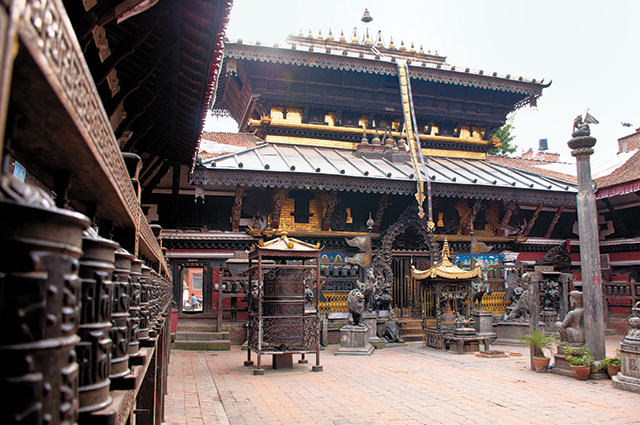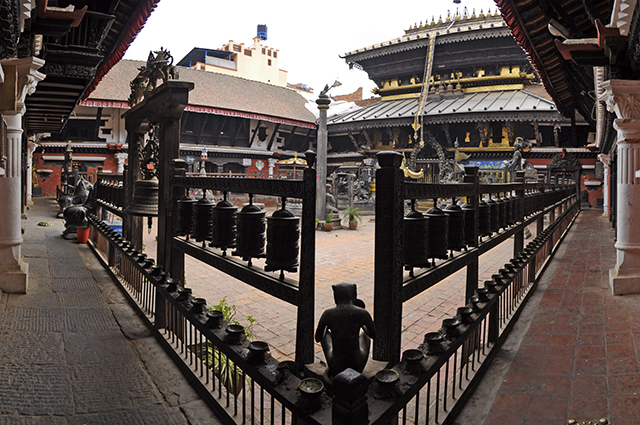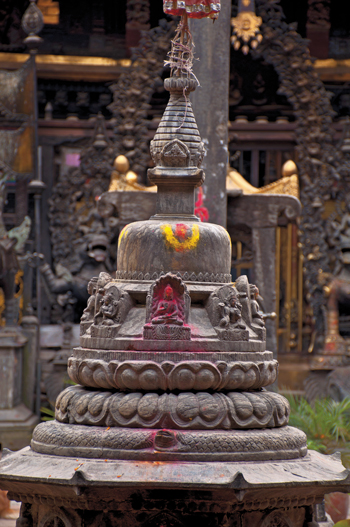Kathmandu Valley is estimated to have more than 2,500 temples of different styles, the most prevalent being the pagoda type. Rudravarna Mahavihar is one of the most beautiful of such pagoda style temples.
 According to those who know, Rudravarna Mahavihar in Okubahal, Lalitpur, is the second most important vihar in Kathmandu Valley, next only to Hiranayavarna Mahavihar, also known as the Golden Temple, in Kwabahal of Lalitpur. The two mahavihars share many similarities, both being three-roofed pagoda-style temples housing huge statues of Shakyamuni Buddha. However, there are differences as well. There are more devotional activities in Hiranayavarna Mahavihar than in Rudravarna Mahavihar, and the former certainly has a livelier environment, especuially in the early hours of the morning, when many devotees come to pray and worship. On the other hand, Rudravarna Mahavihar is said to be the best-maintained vihar in the valley, and is spic-and-span at all hours. Anyway, however one looks at it, it is a fantastic example of Newari Buddhist culture, artchitecture, and art.
According to those who know, Rudravarna Mahavihar in Okubahal, Lalitpur, is the second most important vihar in Kathmandu Valley, next only to Hiranayavarna Mahavihar, also known as the Golden Temple, in Kwabahal of Lalitpur. The two mahavihars share many similarities, both being three-roofed pagoda-style temples housing huge statues of Shakyamuni Buddha. However, there are differences as well. There are more devotional activities in Hiranayavarna Mahavihar than in Rudravarna Mahavihar, and the former certainly has a livelier environment, especuially in the early hours of the morning, when many devotees come to pray and worship. On the other hand, Rudravarna Mahavihar is said to be the best-maintained vihar in the valley, and is spic-and-span at all hours. Anyway, however one looks at it, it is a fantastic example of Newari Buddhist culture, artchitecture, and art.

At the four corners of the vihar are four truly exotic statues of deities made by no less a sculptor than the late Mr. Siddhi Ratna Bajracharya, an icon in the field of metal sculpting. The vihar is full of many other beautiful works of art in metal. This is no surprise, since Okubahal in Lalitpur is the center of metal sculpting in Nepal. So much so, that if you ask around the place, you’ll find that almost every house is involved in metal sculpting! Behind the mahavihar is a spacious courtyard called Ta:Go Chiva, meaning ‘Big Stupa’, which refers to a large white stupa in the center. Rows of houses surround the courtyard, and the first one near the entrance from Mahaboudha Chowk belongs to master sculptor Mr. Sanat Kumar Shakya, who is famous for his exotic Sahasra-bhuja Sahasra-netra ((Thousand-armed, Thousand-eyed Avalokitesvara) figures. He is also one of the committee members responsible for the upkeep of Rudravarna Mahavihar.

The daily worship in the mornings and evenings are conducted by a priest and some elders of the local Shakya clan. Once in his lifetime, a male member of this clan has to be a priest of the vihar for at least two weeks. This is, seemingly, another difference with Hiranyavarna Mahavihar, where the
priest has to be from the Bajracharya clan. Shakya and Bajracharya are branches of the Newar community that conduct religious rituals. Anyway, the priest of Rudravarna Mahavihar is almost always a young man who dresses in black robes during his priestly tenure. As mentioned before, Rudravarna Mahavihar stands in a historic locality, and this is all the more so due to the presence of the renowned Mahaboudha Temple with its one thousand terracota Buddha figures just a few meters away.
Rudravarna Mahavihar has many valuable artifacts within its premises: ancient statues of various deities and symbolic animals, and even a life-size statue of a king, as well as huge bells, mandalas, vajras (thunderbolts), and so on. Apparently, once one of the five brass pinnacles on the top of the temple was stolen, and from that time onwards, it became usual for groups of young Shakya men to take turns in sleeping in the pati within the temple to keep guard on their ancient and precious heritage, which includes some tundals (wooden struts) that are claimed to be the oldest in Nepal. Indeed, all such treasures need extra protection, but like said before, one can take comfort in the fact that the Rudravarna Mahavihar is the best managed (and protected) vihar in the country.










